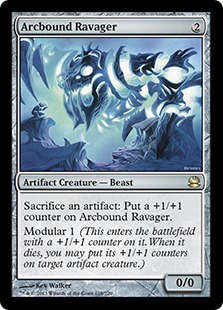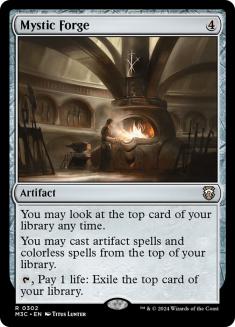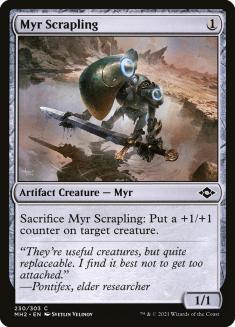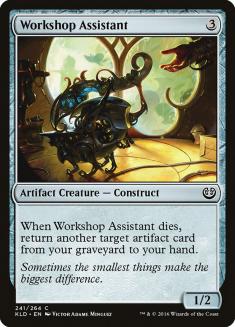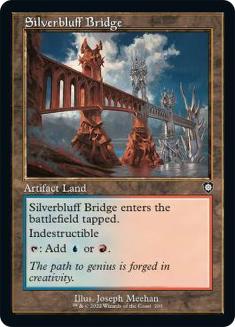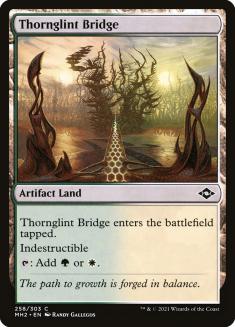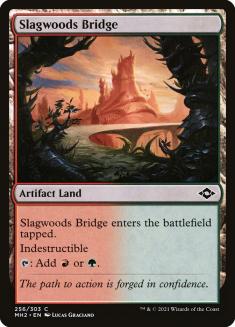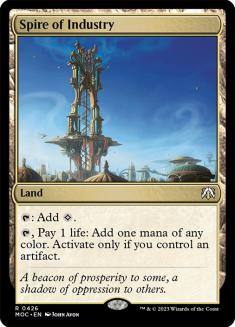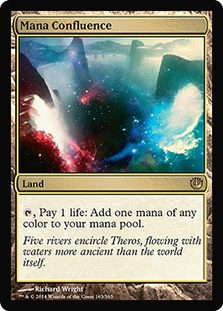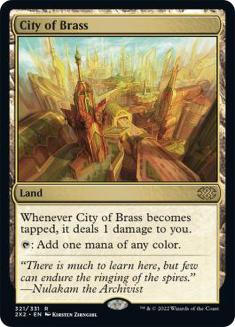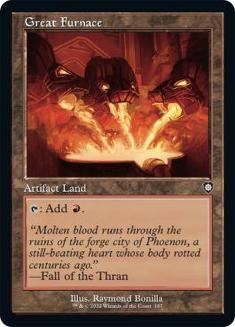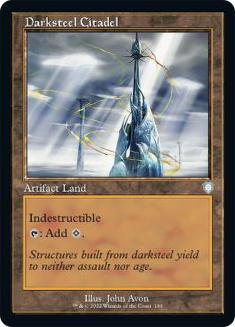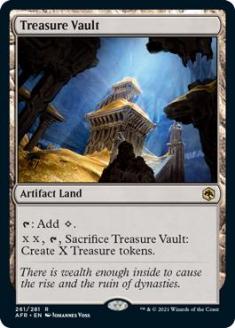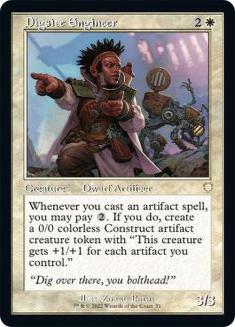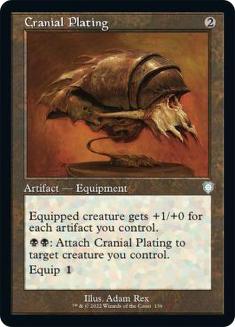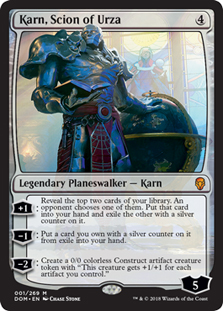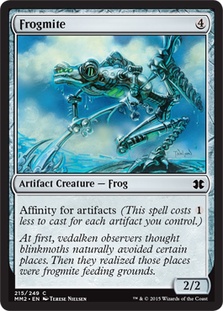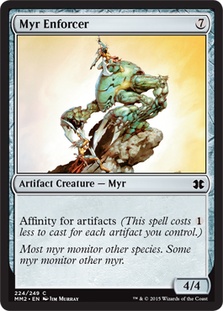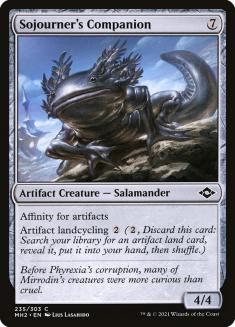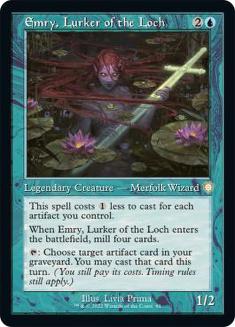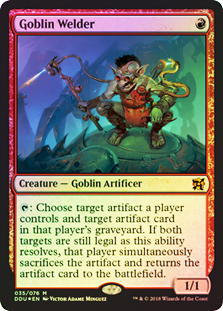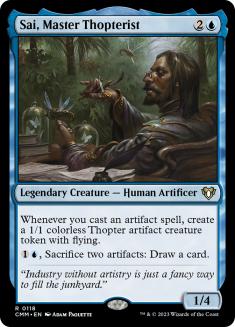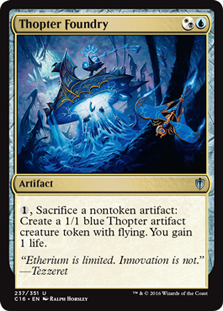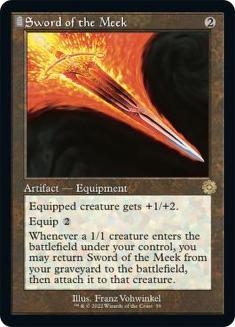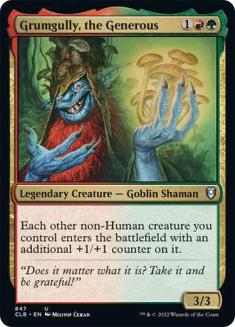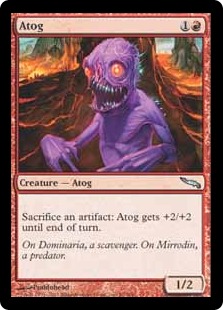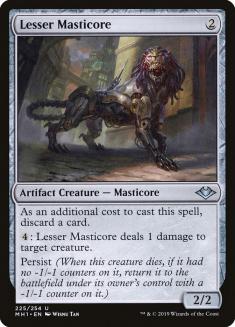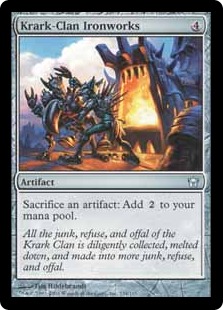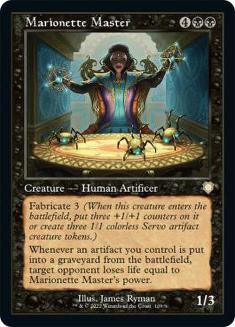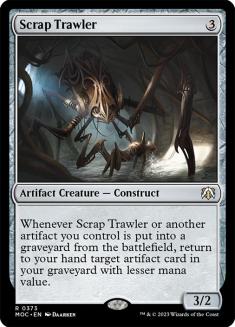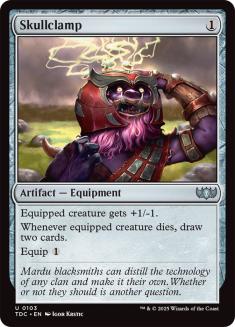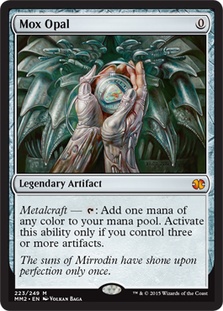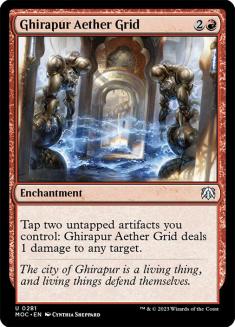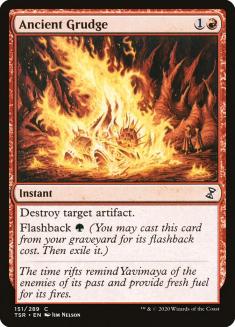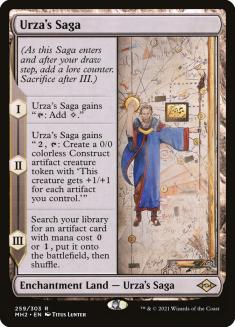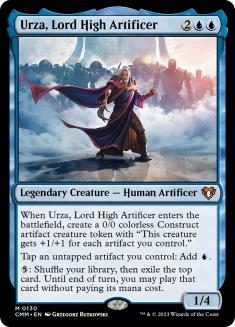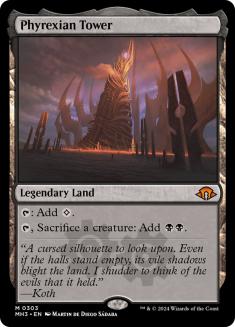With the autumnal equinox upon us and pumpkin spice season in full swing, I’m thinking ahead to the many months of Minnesota winter that I’ll be spending inside (hopefully Cubing). Innistrad: Midnight Hunt has given me much to consider on the Cube design front, but today I’m here to offer a project that I’ve had in my back pocket for a while now.
Today’s topic isn’t Innistradian at all, but rather an old flame rekindled by Modern Horizons 2. Today I would like to introduce you to the Artifact Twobert.
Before we begin, I’ll offer a quick refresher on Twoberts. They’re 180-card Cubes built to be drafted by two to four players. The smaller card pool allows less space for wholly different archetypes, but more potential to deeply explore a smaller set of similar archetypes.
I had originally worked on the concept as a means to offer a better Draft experience for a small number of players. Over time I’ve discovered that the smaller Cube size is great for supporting archetypes that are a poor fit for larger Cubes, such as Death’s Shadow in my Tempo Twobert. You see the namesake cards and role-players more often and you have more control over how competitive the archetype is in the Cube at large, given that you have fewer elements to balance it against.
I worked on designing an artifact Cube a few years back, but I found several elements of the design I was working on frustrating. Aesthetically, I wanted the Cube to overwhelmingly be artifacts, and you just hit a wall at some point in this regard. I specifically was interested in artifact decks that are evocative of historical Constructed decks like Ravager Affinity, something we’ve seen in a number of Spotlight Cubes recently but not nearly on the level that I desired. The power level does some combination of dropping off steeply and bleeding into territory that isn’t much about artifacts at all, and I found both of these ends highly undesirable. I don’t want to have to tell anybody that they’re drafting an artifact Cube. I want the packs to speak for themselves.
The other major issue I had was with the color green, and to a lesser extent colored spells in general. I take no issue with colored artifacts and some amount of colored spells that generate or otherwise care about artifacts, but green cards that reference artifacts tend to be effects that destroy them. I would consider my artifact Cube an abject failure if “Oops! All Shatters” turned out to be the best or even a highly competitive archetype.
For those reasons I had a 360-card design that I had abandoned when I learned that Modern Horizons 2 featured a handful of awesome new toys for an artifact Cube. The set didn’t offer anything of interest to solve my green problem, but with a great spread of new blue, white, and colorless options as well as the 180-card model to work with, I was able to come up with a workable starting point pretty quickly. I really enjoyed the novel play experience the Artifact Twobert offered from the first play. I’ve done some significant tinkering from there, and you can find my current list on Cube Cobra.
There are some serious departures from my previous Twoberts here, which you can see at a glance from the ratio of colorless to colored spells. Aesthetics were a huge part of my motivation for this project; this is reflected not only in the long colorless column but also the sorts of colored spells that made the cut. In terms of gameplay it doesn’t make much difference whether you play with Swords to Plowshares and Lightning Bolt or Dispatch and Galvanic Blast with all other things in the Cube being equal, but the latter pair sells the experience better.
Typically when I break down a Cube I go over things by color, but that’s not best here. The individual color columns just aren’t that long, so instead I’ve compiled a list of broader discussion points that better illuminate what the Artifact Twobert is about.
Ten Monocolored Cards per Color
Let’s start with the rationale for there being so few monocolored cards. I started closer to the base model of building the Cube around 23-card mono-color decks for every color, but with so many more colorless options, this was more limiting than anything. It’s pretty easy to play a mono-color deck with a bunch of colorless cards if that’s what you want to play, and I wanted to do everything I could to make Arcbound Ravager a compelling Pack 1, Pick 1. When the volume of colored spells was higher, more packs had few or occasionally no artifacts, and that just didn’t mesh with my vision for the Cube. The number decreased gradually over time as I experimented with the floor for playable artifacts in this environment. I haven’t missed any of the colored spells as I’ve trimmed them.
Certain colored cards that have played well in the environment ended up on the chopping block. The most pressure to trim down the total number came from the green section. Artifact synergies just aren’t there, and while I’ve been happy supporting Hardened Scales as an archetype, you mostly end up with more effects that destroy artifacts as you expand the green section. You definitely need some artifact destruction, but packs with as many Shatters as artifacts bore me.
You could get into including different numbers of cards for different colors to address this, and I do have some Phyrexian mana stuff and colored activations in the colorless column, but I don’t personally care for any color imbalance that’s heavier-handed than that. Something about the columns of equal length on paper just does it for me.
Two Gold Cards for Each Color Pair
I started this Cube off with my usual three gold cards per color pair like I’ve done with other Twoberts, but it’s pretty clear even at two that some color pairs are much better at accomplishing my goals than others. Any green pair is tough, and Boros and Rakdos are a little wonky as well. It was pretty easy to trim this section as I cut back on monocolored spells.
I was actually down to one gold card for each color pair for a short while, but having to choose between Baleful Strix and Tezzeret, Agent of Bolas was my breaking point on that front. In the end I just couldn’t do it, and if that means that the Cube features both Scab-Clan Mauler and Grumgully, the Generous, then so be it.
I do bend my own rules a bit to include Thopter Foundry in the Cube. I think it’s cool to showcase the card in an environment like this where it’s powerful even without the Sword of the Meek combo. I’ve also wanted to find a different home for that combo ever since it fell flat in the Grixis Twobert.
Urza, Lord High Artificer was in my initial list for the full infinite combo, but I took more issue with how Urza played in the Cube than the combo. More on that when I go over the power level of the Cube later.
Lands
I wasn’t sure how I felt about Bridges when they were previewed for Modern Horizons 2, but they’ve shown up in Constructed Magic some and have proven to be meaningful game pieces in the Artifact Twobert. There’s a bit of a cost with them entering tapped, but there’s enough upside to just being an artifact that I’ve really enjoyed them on balance.
I tried Shocklands and considered painlands for this Cube but ultimately I concluded that two-color lands were mostly a weird fit. Decks only play so many colored spells and there are a few tools that make splashing easy like Chromatic Sphere and Chromatic Star. Two-color lands just didn’t remotely have the appeal of Spire of Industry. Originally I thought that Mana Confluence and City of Brass might cheapen the appeal of Spire, but the five-color painland fit the aesthetic of the Cube and the decks that we were drafting so well that I ultimately landed on just upping the number of five-color lands over including any additional two-color cycle.
You’ll also notice the original artifact lands in the spread. A Turn 1 Seat of the Synod getting hit with an Oxidize isn’t usually the kind of play pattern that I like to encourage, but that is a historical element of Ravager Affinity Standard that I wanted to preserve. Get got nerd. Outside of that specific interaction they tend to offer far more upside than downside.
With those design notes in mind, let’s take a look at what the macro-archetypes in the Cube are getting up to.
Aggressive Decks
The aggressive decks in the Cube tend to lean on affinity and/or modular. Their composition is typically a motley crew of warm bodies and a few synergy cards that put all of the less powerful cards over. Some haymakers at the top-end and some ways to generate giant creatures are the key to victory here.
I’d been slightly skeptical of the ability of Myr Enforcer and Sojourner’s Campanion to hang in the Cube with cards like Skullclamp and Krark-Clan Ironworks in the spread. They’ve far exceeded my expectations with every casting. They’re just bigger than most of the creatures in the Cube as a baseline and a number of games are decided by just presenting the most large threats.
While you are looking to draft a handful of high-impact cards, one of the most important elements of the good aggressive decks in the Artifact Twobert is ensuring that you have plays on every turn of the game. I know that Sparring Construct and Chronomaton don’t look like much, but you’ve gotta get on the battlefield early. It’s also worth noting here that we commonly play around fifteen lands in this Cube as opposed to the usual seventeen. This makes it easier to justify including some marginal one-mana 1/1s. Sometimes you see high-power plays, but a lot of the games end up feeling close to Mirrodin Limited with many small exchanges happening on the battlefield.
Controlling Decks
There’s a decent volume of interactive spells in the Cube, but the controlling decks are more defined by how they close the game than how they interact in this Cube. Again, I’m really not interested in somebody rolling up and just destroying every artifact that the opponent casts, and putting some pressure on the control decks to be proactive is the logical extension of this.
A quirky element of this design is that it’s a lot more difficult than usual to answer nonartifact creatures in the Artifact Twobert. As such, control decks are really looking to leverage some of these difficult-to-answer value engines to pull ahead of aggressive opponents. Goblin Welder and Emry, Lurker of the Loch have rarely looked better.
I’m usually a fan of Lurrus of the Dream-Den in Cube but I actually excluded the card here despite how well it would fit into a lot of the decks; it would detract from the charm of seeing these creatures that tend to underperform in other Cubes shine. As such, Hidden Stockpile contributes a lot more to the intended aesthetic of the Cube.
I tend to value the cantripping artifacts highly based around the strength of a lot of difficult-to-answer colored creatures like Goblin Welder and Emry. Planeswalkers of course. Removal spells, but just going bigger matters most. Decks must be able to beat Skullclamp and whatnot.
The planeswalkers are also fairly significant factors for successful control decks, and Daretti, Ingenious Iconoclast is pretty easily the most powerful control card in the Cube. Beyond some interactive spells and value engines, it’s not uncommon for the controlling decks in the Artifact Twobert to feature a combo finish.
Combo Decks
The combo decks in the Cube come in a couple of different flavors. There’s the aforementioned Thopter-Sword:
Persist combo:
And the wackiest of the lot, Ironworks combo:
Outside of what is more or less a Splinter Twin situation with Marionette Master, the Ironworks decks tend to take you down some bizarre and non-deterministic paths. Krark-Clan Ironworks is pretty plainly one of the most powerful cards in the Cube and it’s not up to anything remotely fair, but it’s a fairly novel combo experience for Cube and I’m happy to give it a home here.
All of these combos are reliant on finding very specific pieces, which I believe is pretty important for the replayability of a small environment like a Twobert. They’re supported enough that they’ll be good when they show up, but the cards won’t always fall in an order that you can easily plan on comboing off.
On Power Level
I’ve mentioned most of these cards by name already, and I find that it’s pretty difficult to pass any of these cards while drafting the Artifact Twobert:
You can’t ever fully get away from some cards being better than others, though all of these are extreme cases that are more powerful than some other cards that have been excluded for undesirable play patterns. For the most part, these cards facilitate proactive gameplans that are evocative of historical Constructed formats, which I like to capture in my Cubes. I’m much less interested in a version of this Cube that doesn’t feature Mox Opal and Skullclamp.
Daretti is a bit different from the rest of the lot in this regard, but the card adds a lot for controlling decks and I also enjoy showing off how much more the 1/1 artifact tokens matter in this environment than in others. As for some powerful cards that I’ve tried that I didn’t like for the Cube, here’s a look at power level outliers that I tried and found undesirable:
All of these cards are beatable, but none of them ever felt like they positively contributed to the gameplay of the Cube. Both Ghirapur Aether Grid and Ancient Grudge just leave a feeling that the opponent is packing a very hateful sideboard for you, which isn’t what I consider the positive aspect of Constructed Magic worth capturing in Cube. Urza, Lord High Artificer is already a very powerful Cube card with little direct support, and the impact that Urza has on a battlefield cluttered with a lot of incidental artifacts makes closing games trivial. Urza’s Saga is an absolute farce of a Magic card, and I will not be taking any questions at this time.
Ancient Tomb was the closest of this lot to staying in the Cube. It’s pretty clear that Tolarian Academy would be way over the line, but once I firmly committed to Mox Opal I wanted to try some other means of fast mana. It just happened that Ancient Tomb felt that it was asking way too little of the person playing it, and this removed all of the charm that Mox Opal provides. Even if the Cube makes it very easy to turn Mox Opal on, it does at least require some base acknowledgement of the core concept of the Cube and likely influences your pick order.
After disliking Ancient Tomb, I gave Phyrexian Tower a shot. That swap has been awesome for the Cube. There are some expendable bodies which make it powerful but not oppressive, it’s a neat way to use modular as a combat trick, and it provides the exact mana required to attach Cranial Plating at instant speed. All of that, plus the aesthetic association of Phyrexia and artifacts. It’s poetry in motion.
I’m not sure whether my Artifact Twobert or the Grixis Cube departs more from traditional Cubes, but all the same it has been a fun and informative exercise for me in exploring what is possible for Cube, and Twoberts specifically. The way that this Twobert feels and plays so much differently from my previous designs has been really exciting for me. I hope you see something in this design that you enjoy or find thought-provoking as well.


